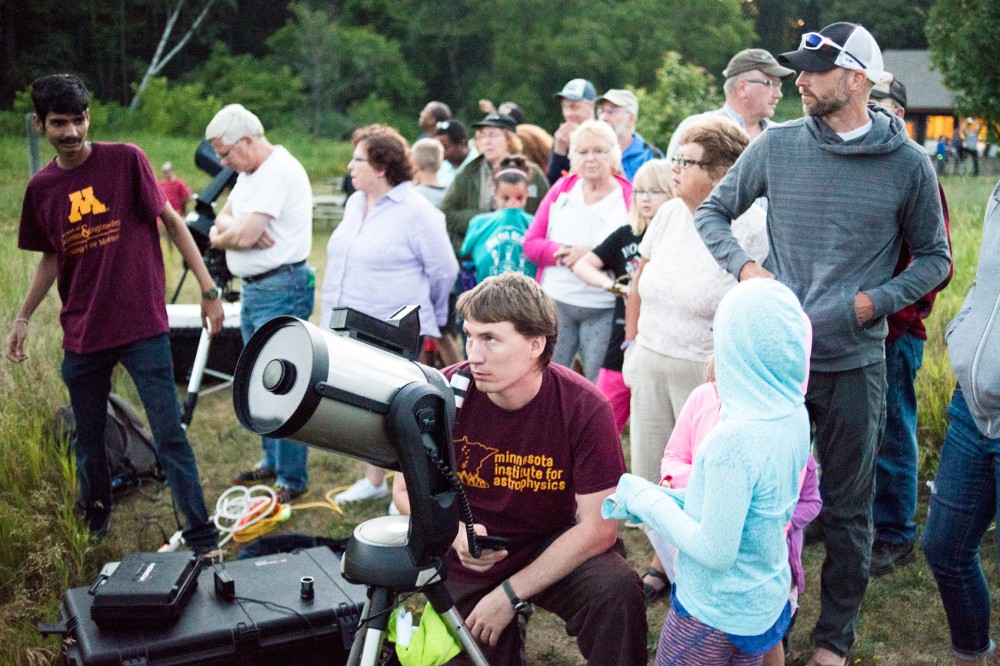As Norm and Toots Marohn of Andover, Minn., waited for the program to begin, their granddaughter Hannah impatiently flipped through a book on naturalism.
“We’ve tried going to this event before — maybe three or four times we’ve tried — but it’s always been cloudy,” Toots Marohn said.
The Marohns were camping with their children and grandchildren at William O’Brien State Park on the St. Croix River over the weekend of July 1, where on a clear evening they attended Universe in the Park — a weekly summer telescope observation program organized by the Minnesota Institute for Astrophysics and the University of Minnesota.
Evan Skillman, a professor of astrophysics and Universe in the Park director, said he founded the program 11 years ago with funding from a NASA outreach grant. The program, now funded through the Minnesota Space Grant Consortium, is put on with help from state and local parks.
“We allow people in the public in an informal setting to ask questions about astronomy and physics,” Skillman said. “What I’ve found is basically everybody has questions, and they’d like to talk to somebody who does this professionally. … At the parks we have a captured audience.”
On July 2, about 50 people of all ages gathered for Universe in the Park at William O’Brien State Park. Some ambled around looking at taxidermied animals in the visitor center’s information room; others walked the park’s trails, and some waited silently for the program to begin.
Karl Young, one of three University graduate students staging the program that night, fiddled with a telescope’s view finder. Young, who is now in his third year with the program, said the connections he makes with stargazers is what keeps him coming back.
Tian Qin, an earth sciences graduate student, and Lisa Ling looked through a telescope before the program started. Ling had recently arrived from China for a monthlong stay when she learned about Universe in the Park.
“We just discovered this today,” Ling said. “I like the stars, and we wanted to see them. … We drove from Minneapolis.”
At about 8:15 p.m., Cody Carr and Sourabh Chauhan, both University of Minnesota astrophysics graduate students and program coordinators, began the evening with a lecture about the solar system.
The room, adorned with a scale model of the solar system, was filled to capacity, and many stood along the edge to let children sit in the middle.
Beginning at the sun, Carr and Canhan worked their way to the Oort cloud, using video and satellite pictures to explain what the celestial bodies in the solar system are believed to be made from and how they developed. The pair also explained how satellites are used to study the solar system, highlighting the NASA Juno probe’s orbit around Jupiter, which began Monday.
After the 20-minute lecture, the duo fielded questions from attendees, which ranged from the origins of the earth’s moon to the intricate processes of the sun’s power — like nuclear fusion.
Sheila Kelleher, a senior quality analyst at a University of Minnesota research program, drove from Minneapolis to attend the event after finding out about it the day before.
“I really like astronomy, but I signed up for an astronomy course in college and realized it was mostly math,” Kelleher said, adding that her lifelong interest in the stars can be attributed to the beauty she finds in the celestial pictures.
The line stretched as people took turns looking at Jupiter and Saturn, both of which were vaguely visible to the naked eye. During their wait, some children turned to games of tag and catch for entertainment. Others covered themselves in bug spray while slapping at mosquitoes.
After gazing, some walked back to their cars or campsites. Some stayed to ask the graduate students more questions.
“I really like it — just interacting with the people is really exciting and motivating,” Carr said.
Universe in the Park is free and runs through August 13.

















